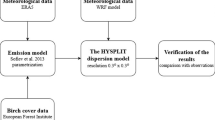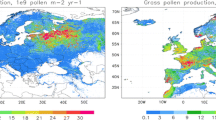Abstract
Pollen concentrations on Alpine mountain tops are poorly known due to few observations and few modeling studies. We present two case studies from the Alps that provide insights into the spatial and temporal distribution of birch pollen. The numerical pollen dispersion model COSMO-ART (COnsortium for Small-scale MOdelling-Aerosols and Reactive Trace gases) was used to simulate the birch pollen transport during the 2017 pollen season. The model configuration included 1.1-km horizontal grid spacing and 80 vertical levels. The simulations were compared with daily pollen concentrations from two mountain tops in the Alps (Weissfluhjoch near Davos, Switzerland, at 2692 m and Schneefernerhaus, Germany, at 2650 m a.s.l.). In addition, the Swiss pollen stations at Davos (1587 m a.s.l.) and Buchs (446 m a.s.l.) were used. COSMO-ART simulations agreed well with the observations at Davos and Weissfluhjoch. At the Environmental Research Station Schneefernerhaus, the pollen concentrations were generally overestimated. We analyzed the pollen transport episode of 9 April 2017 at Weissfluhjoch in more detail using vertical cross sections of the COSMO-ART simulations. The results suggest that pollen can be lifted up to 3000 m in the morning hours and are subsequently transported by large-scale winds leading to higher birch pollen concentrations at Weissfluhjoch than at Davos. This suggests that the actual situation regarding sources, topography and wind determines the pollen distribution and not only altitude. Still, pollen levels at Weissfluhjoch are more than one order of magnitude lower than typical pollen levels at lowland Swiss stations such as Buchs.



Similar content being viewed by others
References
Clot, B., Peeters, A. G., Fankhauser, A., & Frei, T. (1995). Airborne pollen in Switzerland 1994. Zürich: Schweizerische Meteorologische Anstalt.
D’Amato, G., Cecchi, L., Bonini, S., Nunes, C., Annesi-Maesano, I., & Behrendt, H. (2007). Allergenic pollen and pollen allergy in Europe. Allergy,62, 976–990.
Eder, W., Ege, M. J., & von Mutius, E. (2006). The asthma epidemic. The New England Journal of Medicine,355, 2226–2235.
Gehrig, R., Köhler, B., Clot, B., Herren, T., Graber, M.-J., Hauser, M., Moersen, M., & Sallin, C. (2012). Luftpollengehalt in der Schweiz 2011. Resource document. MeteoSwiss. https://www.meteoschweiz.admin.ch/content/dam/meteoswiss/de/service-und-publikationen/Publikationen/doc/Pollen-Jahresbericht_2011_d.pdf. Accessed 23 Oct 2018.
Gehrig, R., & Peeters, A. G. (2000). Pollen distribution at elevations above 1000 m in Switzerland. Aerobiologia,16, 69–74.
Jochner, S., Ziello, C., Böck, A., Estrella, N., Buters, J., Weichenmeier, I., et al. (2012). Spatio-temporal investigation of flowering dates and pollen counts in the topographically complex Zugspitze area on the German–Austrian border. Aerobiologia,28, 541–556.
Markgraf, V. (1980). Pollen dispersal in a mountain area. Grana,19, 127–146.
Pace, L., Boccacci, L., Casilli, M., Di Carlo, P., & Fattorini, S. (2018). Correlations between weather conditions and airborne pollen concentration and diversity in a Mediterranean high-altitude site disclose unexpected temporal patterns. Aerobiologia,34, 75–87.
Sofiev, M., Berger, U., Prank, M., Vira, J., Arteta, J., Belmonte, J., et al. (2016). MACC regional multi-model ensemble simulations of birch pollen dispersion in Europe. Atmospheric Chemistry and Physics,15, 8115–8130.
Vogel, B., Vogel, H., Bäumer, D., Bangert, M., Lundgren, K., Rinke, R., et al. (2009). The comprehensive model system COSMO-ART—Radiative impact of aerosol on the state of the atmosphere on the regional scale. Atmospheric Chemistry and Physics,9, 8661–8680.
Vogel, H., Pauling, A., & Vogel, B. (2008). Numerical simulation of birch pollen dispersion with an operational weather forecast system. International Journal of Biometeorology,52, 805–814.
Acknowledgements
We thank the team of the Institute for Snow and Avalanche Research in Davos and the team of the Environmental Research Station Schneefernerhaus for their accurate service w.r.t. to the pollen traps. Likewise, we are grateful to Guy de Morsier from MeteoSwiss for his help in preparing Figs. 1 and 3. This study was also supported by the Swiss National Supercomputing Centre (CSCS) under project ID s83.
Author information
Authors and Affiliations
Corresponding author
Rights and permissions
About this article
Cite this article
Pauling, A., Clot, B., Menzel, A. et al. Pollen forecasts in complex topography: two case studies from the Alps using the numerical pollen forecast model COSMO-ART. Aerobiologia 36, 25–30 (2020). https://doi.org/10.1007/s10453-019-09590-2
Received:
Accepted:
Published:
Issue Date:
DOI: https://doi.org/10.1007/s10453-019-09590-2




